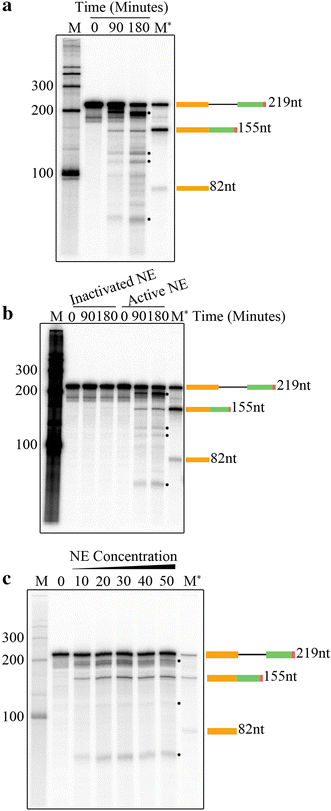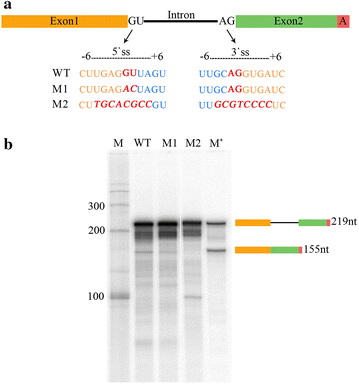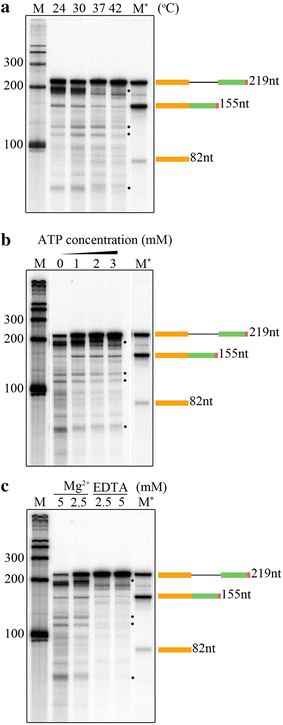Development of an in vitro pre-mRNA splicing assay using plant nuclear extract
- PMID: 29321806
- PMCID: PMC5757305
- DOI: 10.1186/s13007-017-0271-6
Development of an in vitro pre-mRNA splicing assay using plant nuclear extract
Abstract
Background: Pre-mRNA splicing is an essential post-transcriptional process in all eukaryotes. In vitro splicing systems using nuclear or cytoplasmic extracts from mammalian cells, yeast, and Drosophila have provided a wealth of mechanistic insights into assembly and composition of the spliceosome, splicing regulatory proteins and mechanisms of pre-mRNA splicing in non-plant systems. The lack of an in vitro splicing system prepared from plant cells has been a major limitation in splicing research in plants.
Results: Here we report an in vitro splicing assay system using plant nuclear extract. Several lines of evidence indicate that nuclear extract derived from Arabidopsis seedlings can convert pre-mRNA substrate (LHCB3) into a spliced product. These include: (1) generation of an RNA product that corresponds to the size of expected mRNA, (2) a junction-mapping assay using S1 nuclease revealed that the two exons are spliced together, (3) the reaction conditions are similar to those found with non-plant extracts and (4) finally mutations in conserved donor and acceptor sites abolished the production of the spliced product.
Conclusions: This first report on the plant in vitro splicing assay opens new avenues to investigate plant spliceosome assembly and composition, and splicing regulatory mechanisms specific to plants.
Keywords: Arabidopsis; In vitro splicing; Plant in vitro splicing; Pre-mRNA; Splicing.
Figures





Similar articles
-
Preparation of Splicing Competent Nuclear Extract from Mammalian Cells and In Vitro Pre-mRNA Splicing Assay.Methods Mol Biol. 2017;1648:11-26. doi: 10.1007/978-1-4939-7204-3_2. Methods Mol Biol. 2017. PMID: 28766286 Free PMC article.
-
Pre-mRNA splicing in plants: characterization of Ser/Arg splicing factors.Proc Natl Acad Sci U S A. 1996 Apr 2;93(7):3074-9. doi: 10.1073/pnas.93.7.3074. Proc Natl Acad Sci U S A. 1996. PMID: 8610170 Free PMC article.
-
Pre-mRNA splicing in higher plants.Trends Plant Sci. 2000 Apr;5(4):160-7. doi: 10.1016/s1360-1385(00)01595-8. Trends Plant Sci. 2000. PMID: 10740297 Review.
-
Splicing of yeast nuclear pre-mRNA in vitro requires a functional 40S spliceosome and several extrinsic factors.Genes Dev. 1987 Mar;1(1):7-18. doi: 10.1101/gad.1.1.7. Genes Dev. 1987. PMID: 3322937
-
Mechanisms and Regulation of Alternative Pre-mRNA Splicing.Annu Rev Biochem. 2015;84:291-323. doi: 10.1146/annurev-biochem-060614-034316. Epub 2015 Mar 12. Annu Rev Biochem. 2015. PMID: 25784052 Free PMC article. Review.
Cited by
-
Speed breeding advancements in safflower (Carthamus tinctorius L.): a simplified and efficient approach for accelerating breeding programs.Mol Breed. 2025 Jan 9;45(1):13. doi: 10.1007/s11032-024-01530-4. eCollection 2025 Jan. Mol Breed. 2025. PMID: 39803633
-
Plant serine/arginine-rich proteins: versatile players in RNA processing.Planta. 2023 May 5;257(6):109. doi: 10.1007/s00425-023-04132-0. Planta. 2023. PMID: 37145304 Review.
-
Alternative Splicing and Protein Diversity: Plants Versus Animals.Front Plant Sci. 2019 Jun 12;10:708. doi: 10.3389/fpls.2019.00708. eCollection 2019. Front Plant Sci. 2019. PMID: 31244866 Free PMC article. Review.
-
Phytophthora effector PSR1 hijacks the host pre-mRNA splicing machinery to modulate small RNA biogenesis and plant immunity.Plant Cell. 2022 Aug 25;34(9):3443-3459. doi: 10.1093/plcell/koac176. Plant Cell. 2022. PMID: 35699507 Free PMC article.
-
RNA Binding Motif Protein 48 Is Required for U12 Splicing and Maize Endosperm Differentiation.Plant Cell. 2019 Mar;31(3):715-733. doi: 10.1105/tpc.18.00754. Epub 2019 Feb 13. Plant Cell. 2019. PMID: 30760564 Free PMC article.
References
-
- Hernandez N, Keller W. Splicing of in vitro synthesized messenger RNA precursors in HeLa cell extracts. Cell. 1983;35(1):89–99. - PubMed
-
- Krainer AR, Maniatis T, Ruskin B, Green MR. Normal and mutant human beta-globin pre-mRNAs are faithfully and efficiently spliced in vitro. Cell. 1984;36(4):993–1005. - PubMed
-
- Padgett RA, Konarska MM, Grabowski PJ, Hardy SF, Sharp PA. Lariat RNA’s as intermediates and products in the splicing of messenger RNA precursors. Science. 1984;225(4665):898–903. - PubMed
-
- Lin RJ, Newman AJ, Cheng SC, Abelson J. Yeast mRNA splicing in vitro. J Biol Chem. 1985;260(27):14780–14792. - PubMed
LinkOut - more resources
Full Text Sources
Other Literature Sources

